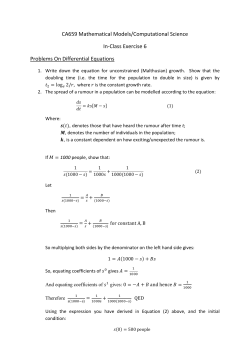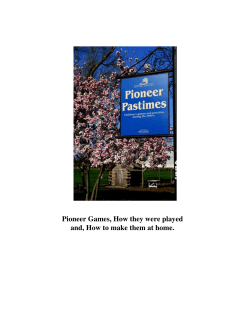
Sample multiple choice questions that test higher order thinking and... Content areas: economics, physics, psychology, ethics, and philosophy
Sample multiple choice questions that test higher order thinking and application, Content areas: economics, physics, psychology, ethics, and philosophy Collected by Kimberly Green, Washington State University Office of Assessment of Teaching and Learning Developing Complex Application Questions Devising multiple choice questions that measure higher level cognitive skills will enable you to test such skills in large classes without spending enormous amounts of time grading. In an evaluation question, a situation is described in a short paragraph and then a problem is posed as the stem of the question. All the rules for writing multiple choice items described above also apply to writing evaluation questions, but students must use judgment and critical thinking to answer them correctly. In the example below (adapted from Welsh, 1978), students must understand the concepts of price inflation, aggregate private demand, and tight monetary policy. They must also be able to analyze the information presented and, based on projected effects, choose the most appropriate policy. This question requires critical thinking and the complex application of economic principles learned in the course. “ B e c a use of rapidly rising national defense expenditures, it is anticipated that Country A will experience a price inflation unless measures are taken to restrict the growth of aggregate private demand. Specifically, the gover nment is considering either (1) increasing personal income tax ra tes or (2) introducing a very tight monetary policy. ” If the government of Country A wishes to minimize the adverse effect of its anti -inflationary policies on economic growth, which one of the f ollowing policies should it use ? a. The tight money policy b ecause it restricts consumption expenditures more than investment. b. The tight money policy, since the tax increase would restrict consumption expenditures. c. The personal income tax increase since it restricts consumption expenditures more than investme nt. d. Either the tight money policy or the personal income tax rate increase since both depress investment equally. Instructors have developed similar questions for analysis and interpretation of poetry, literature, historical documents, and various kinds of scientific data. From http://cfe.unc.edu/pdfs/FYC8.pdf University of North Carolina, Chapel Hill 1 From CLASSROOM TEST OF SCIENTIFIC REASONING Multiple Choice Version Revised Edition: August 2000 by Anton E. Lawson, Arizona State University. Based on: Lawson, A.E. 1978. Development and validation of the classroom test of formal reasoning. Journal of Research in Science Teaching, 15(1): 11-24. 1. Suppose you are given two clay balls of equal size and shape. The two clay balls also weigh the same. One ball is flattened into a pancake-shaped piece. Which of these statements is correct? a. The pancake-shaped piece weighs more than the ball b. The two pieces still weigh the same c. The ball weighs more than the pancake-shaped piece 2. because a. the flattened piece covers a larger area. b. the ball pushes down more on one spot. c. when something is flattened it loses weight. d. clay has not been added or taken away. e. when something is flattened it gains weight. 3. To the right are drawings of two cylinders filled to the same level with water. The cylinders are identical in size and shape. Also shown at the right are two marbles, one glass and one steel. The marbles are the same size but the steel one is much heavier than the glass one. When the glass marble is put into Cylinder 1 it sinks to the bottom and the water level rises to the 6th mark. If we put the steel marble into Cylinder 2, the water will rise a. to the same level as it did in Cylinder 1 b. to a higher level than it did in Cylinder 1 c. to a lower level than it did in Cylinder 1 4. because a. the steel marble will sink faster. b. the marbles are made of different materials. c. the steel marble is heavier than the glass marble. d. the glass marble creates less pressure. e. the marbles are the same size. 2 Farmer Brown was observing the mice that live in his field. He discovered that all of them were either fat or thin. Also, all of them had either black tails or white tails. This made him wonder if there might be a link between the size of the mice and the color of their tails. So he captured all of the mice in one part of his field and observed them. Below are the mice that he captured. 19. Do you think there is a link between the size of the mice and the color of their tails? a. appears to be a link b. appears not to be a link c. cannot make a reasonable guess 20. because a. there are some of each kind of mouse. b. there may be a genetic link between mouse size and tail color. c. there were not enough mice captured. d. most of the fat mice have black tails while most of the thin mice have white tails. e. as the mice grew fatter, their tails became darker. 3 MULTIPLE CHOICE TEST – ETHICS/PHILSOPHY University of Kansas, Fall2004 Philosophy 160: Introduction to Ethics Ben Eggleslon—egglestongkuedu Tuesday, September 28,2004 III. Utilitarianism 7. Why, according to utilitarianism, should laws not impose unnecessary restrictions on individuals' freedom? (A) because individuals have a natural right to freedom (B) because restrictions on freedom tend to diminish happiness (C) because it is expensive to hire police officers to enforce freedom-restricting laws (D) because the laws are based on a social contract, and the idea of the social contract entails maximizing individuals' freedom 8. Suppose that a dangerous defendant who will otherwise be acquitted can be convicted through the giving of false testimony. In the following dialogues, which statement is inconsistent with utilitarianism? (A) Eric; "Giving false testimony is unjust and, therefore, immoral." (B) Fred: "Not all conduct traditionally regarded as unjust is immoral." (C) Eric: "Well, giving false testimony is illegal in nearly every society." (D) Fred: "Well, that does not necessarily mean it's immoral." 9. Which of the following statements is the strongest evidence that the person saying it is a utilitarian? (A) Ginny; "Violations of rights are very serious, from the moral point of view." (B) Helen: "I agree. It is always immoral to violate someone's rights." (C) Ginny: "Well, I wouldn't say 'always'. It's o.k, to violate rights whenever the good you can produce by doing so outweighs the harm you do by violating the person's rights." (D) Kate: "I disagree with both of you. In my opinion, it's immoral to violate someone's rights unless doing so is the only way to prevent that person from violating others' rights." 10. Consider the question, "What is meant by the charge that utilitarianism is too demanding?" Now suppose the following answer is given: "Utilitarianism requires moral people to respond to important moral concerns such as helping the less fortunate, while allowing immoral people to pursue their careers, family lives, and personal projects." What is wrong with this answer? (A) Nothing - that answer is correct. (B) It falsely describes what utilitarianism requires of moral people. (C) It falsely describes what utilitarianism allows of immoral people. (D) It relies on a false dichotomy between moral people and immoral people. IV. Kant's Moral Theory 11. Suppose a person named Nick tells you to give $100 to the United Way, and you say that you are perfectly happy with the charitable contributions that you currently mate (which do not include anything for the United Way). What response from Nick would indicate to you that he meant his remark categorically? (A) "It doesn't matter whether you are already happy; you still have to give $100 to the United Way." (B) "O.k., if you are perfectly happy with the charitable contributions you currently make, then I withdraw what I said." (C) "I'm not making this request of just you; I'm telling every adult human being that they have to give $100 to the United Way, too." (D) "You may think you are perfectly happy with the charitable contributions you currently make, but giving $100 to the United Way will make you even happier." 4 Two part question using one scenario (used for discussion in a large lecture class) [from Dr. Sam Swindell, Psychology, WSU]: APPLICATION 1: The Scenario • While watching TV, you see a public service announcement that claims the following: “Last year, 250,000 individuals died in car accidents when they were not wearing their seatbelts. This shows how dangerous it is to drive without your seatbelt fastened. Be Safe. Buckle Up.” Assuming the statistic is true, is the conclusion valid? That is to say, does wearing your seatbelt increase the likelihood that you will survive a car accident? A. Yes B. No C. Cannot determine based on insufficient information APPLICATION 1: The Scenario • While watching TV, you see If you said “Yes” in a public service announcement that claims the following: “Last year, 250,000 individuals died in car accidents when they were not wearing their seatbelts. This shows how dangerous it is to drive without your seatbelt fastened. Be Safe. Buckle Up.” response to the previous question, you committed which of the following violations in rationality? A. B. C. D. Ignoring baseline rates Framing effect Small sample bias Conjunction fallacy 5
© Copyright 2025





















